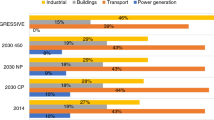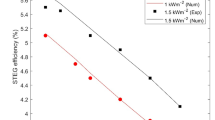Abstract
We have developed a model for finding the most efficient way of increasing the power obtained from a thermoelectric generator (TEG) module with a variety of operating conditions and limitations. The model is based on both thermoelectric principles and thermal resistance circuits, because a TEG converts heat into electricity consistent with these two theories. It is essential to take into account thermal contact resistance when estimating power generation. Thermal contact resistance causes overestimation of the measured temperature difference between the hot and cold sides of a TEG in calculation of the theoretical power generated, i.e. the theoretical power is larger than the experimental power. The ratio of the experimental open-loop voltage to the measured temperature difference, the effective Seebeck coefficient, can be used to estimate the thermal contact resistance in the model. The ratio of the effective Seebeck coefficient to the theoretical Seebeck coefficient, the Seebeck coefficient ratio, represents the contact conditions. From this ratio, a relationship between performance and different variables can be developed. The measured power generated by a TEG module (TMH400302055; Wise Life Technology, Taiwan) is consistent with the result obtained by use of the model; the relative deviation is 10%. Use of this model to evaluate the most efficient means of increasing the generated power reveals that the TEG module generates 0.14 W when the temperature difference is 25°C and the Seebeck coefficient ratio is 0.4. Several methods can be used triple the amount of power generated. For example, increasing the temperature difference to 43°C generates 0.41 W power; improving the Seebeck coefficient ratio to 0.65 increases the power to 0.39 W; simultaneously increasing the temperature difference to 34°C and improving the Seebeck coefficient ratio to 0.5 increases the power to 0.41 W. Choice of the appropriate method depends on the limitations of system, the cost, and the environment.
Similar content being viewed by others
References
D.T. Crane, J. Electron. Mater. 40, 561 (2011).
N.Q. Nguyen and K.V. Pochiraju, Appl. Therm. Eng. 51, 1 (2013).
T.J. Hendricks, N.K. Karri, T.P. Hogan, and C.J. Cauchy, J. Electron. Mater. 42, 1725 (2013).
F. Meng, L. Chen, and F. Sun, Energy 36, 3513 (2011).
S. Kim, Appl. Energy 102, 1458 (2013).
C.T. Hsu, G.Y. Huang, H.S. Chu, B. Yu, and D.J. Yao, Appl. Energy 88, 5173 (2011).
D. Champier, J.P. Bédécarrats, T. Kousksou, M. Rivaletto, F. Strub, and P. Pignolet, Energy 36, 1518 (2011).
G.Y. Huang and D.J. Yao, J. Electron. Mater. 42, 1982 (2013).
N.R. Kristiansen, G.J. Snyder, H.K. Nielsen, and L. Rosendahl, J. Electron. Mater. 41, 1024 (2012).
S. Kumar, S.D. Heister, X. Xu, J.R. Salvador, and G.P. Meisner, J. Electron. Mater. 42, 665 (2013).
Y.Y. Hsiao, W.C. Chang, and S.L. Chen, Energy 35, 1447 (2010).
R. Mccarty, J. Electron. Mater. 42, 1504 (2013).
K. Yazawa and A. Shakouri, J. Electron. Mater. 42, 1946 (2013).
K. Yazawa and A. Shakouri, J. Appl. Phys. 111, 024509 (2012).
Author information
Authors and Affiliations
Corresponding author
Rights and permissions
About this article
Cite this article
Huang, GY., Hsu, CT. & Yao, DJ. Model for Increasing the Power Obtained from a Thermoelectric Generator Module. J. Electron. Mater. 43, 2337–2343 (2014). https://doi.org/10.1007/s11664-014-3059-8
Received:
Accepted:
Published:
Issue Date:
DOI: https://doi.org/10.1007/s11664-014-3059-8




